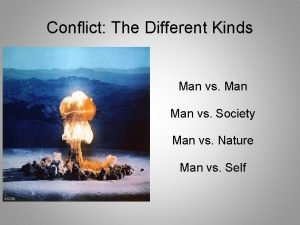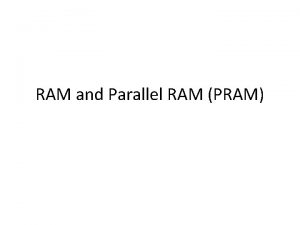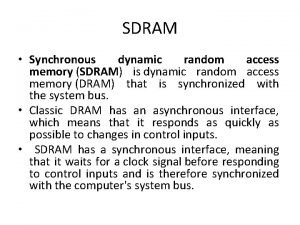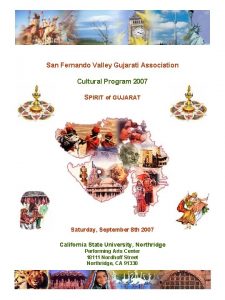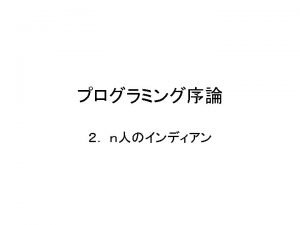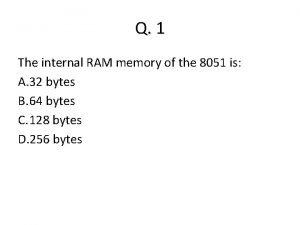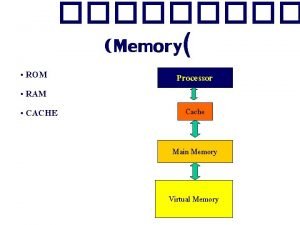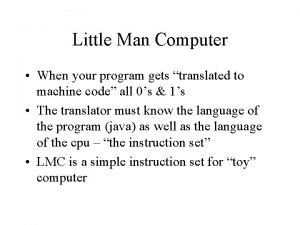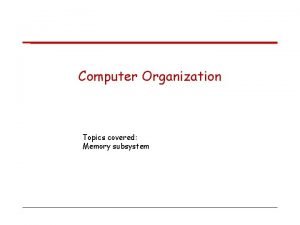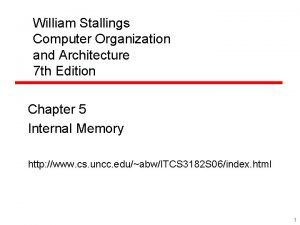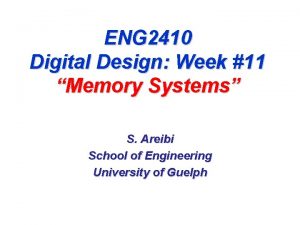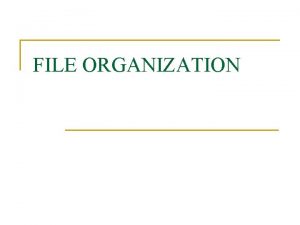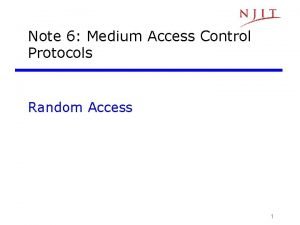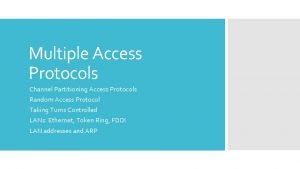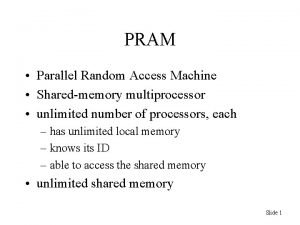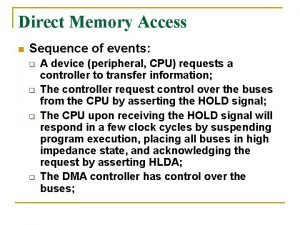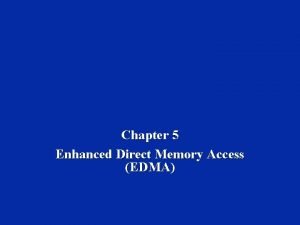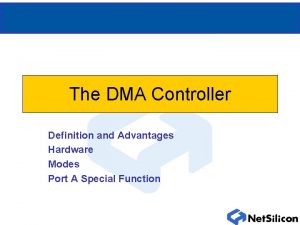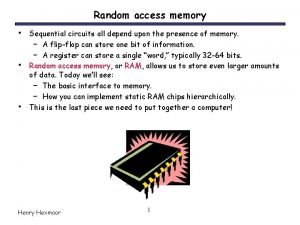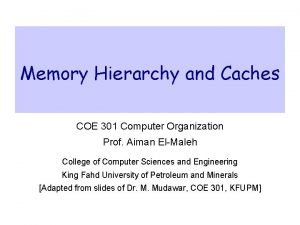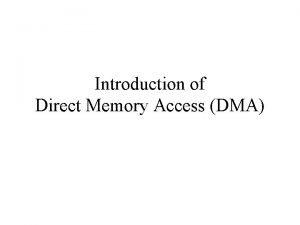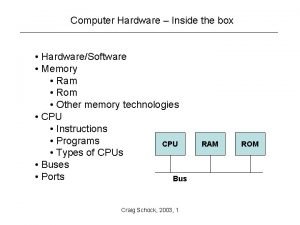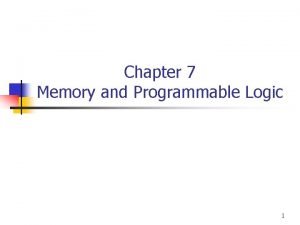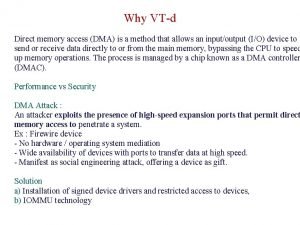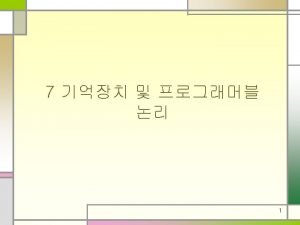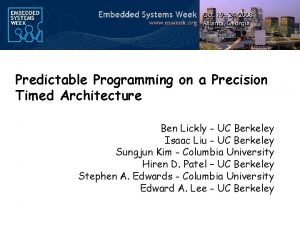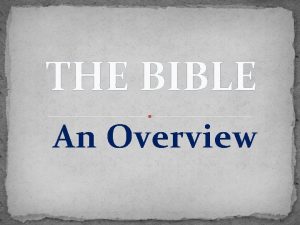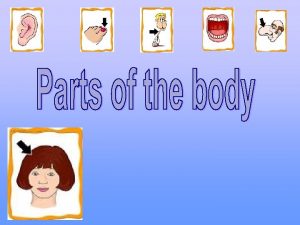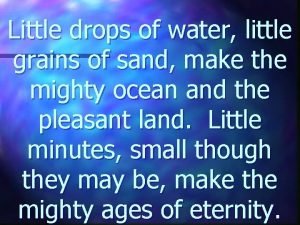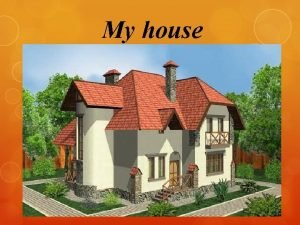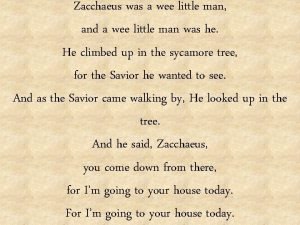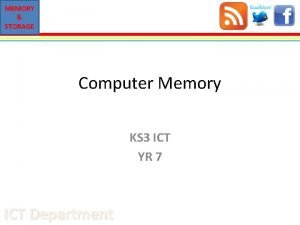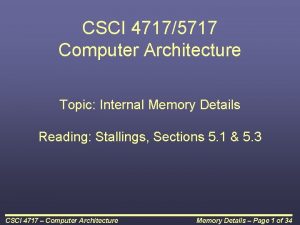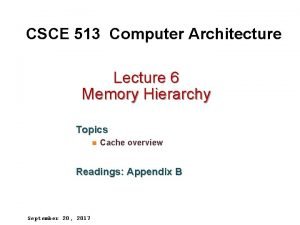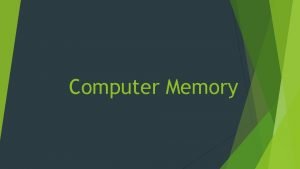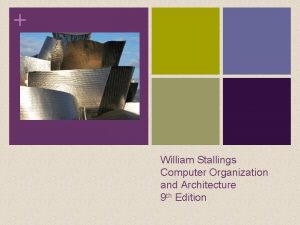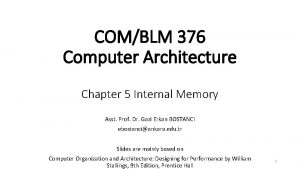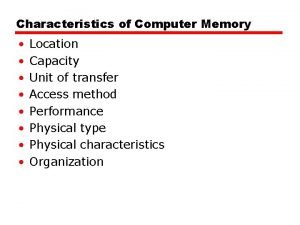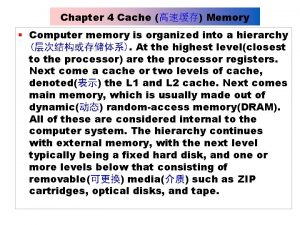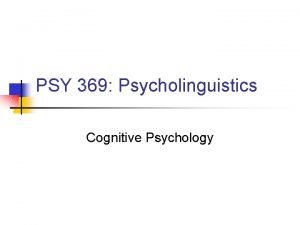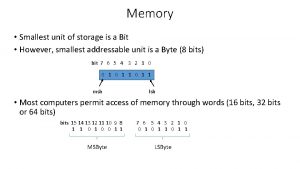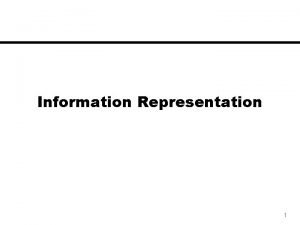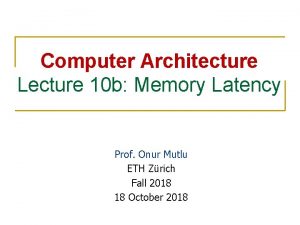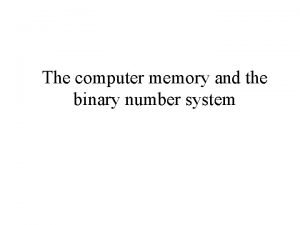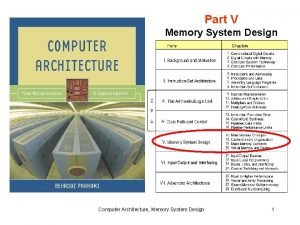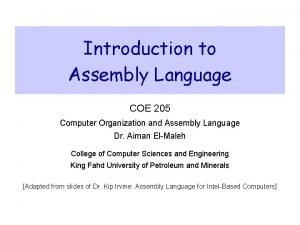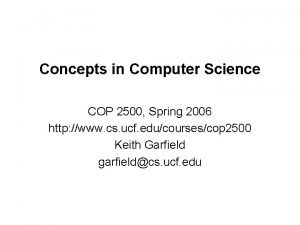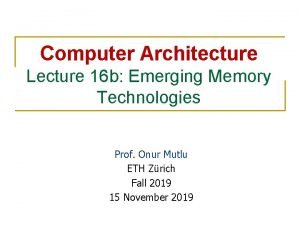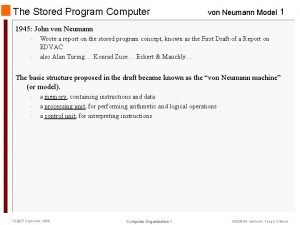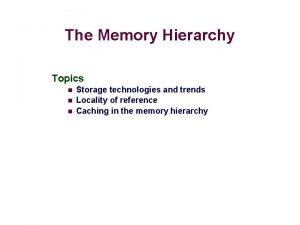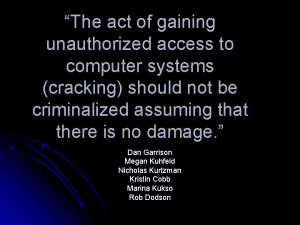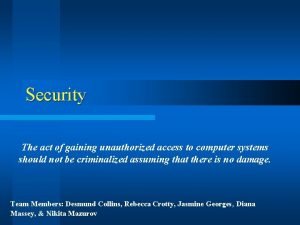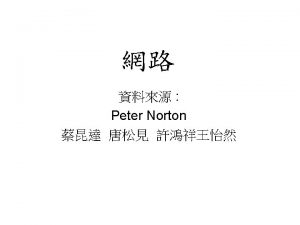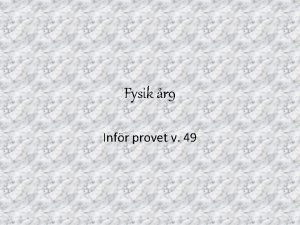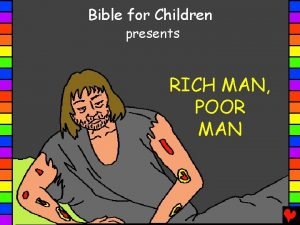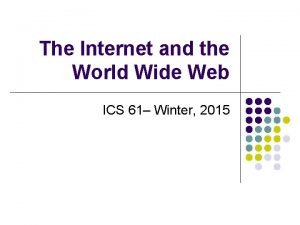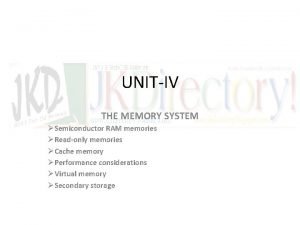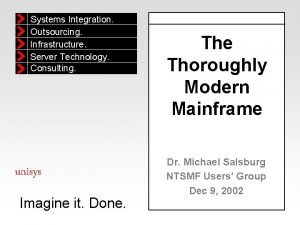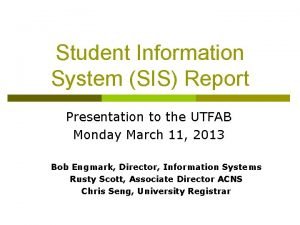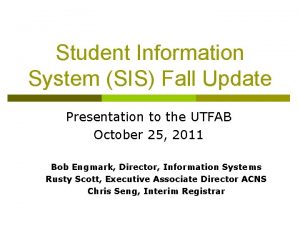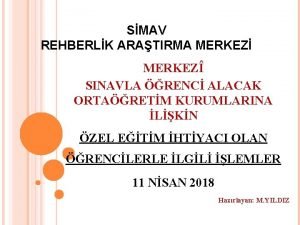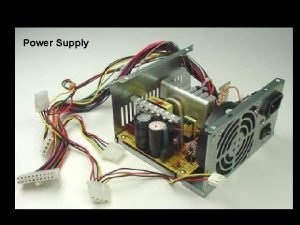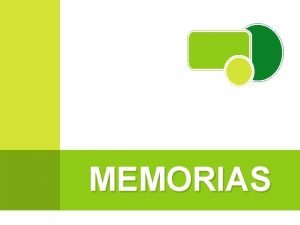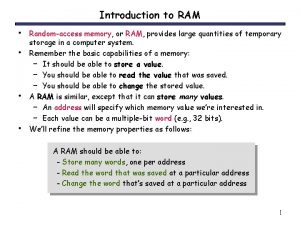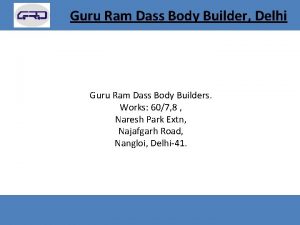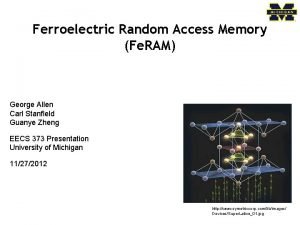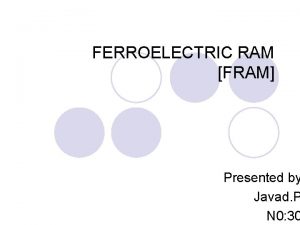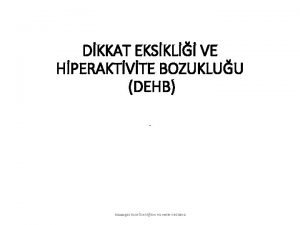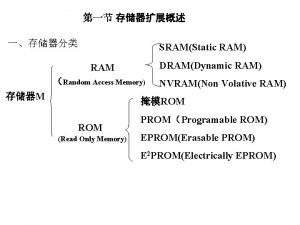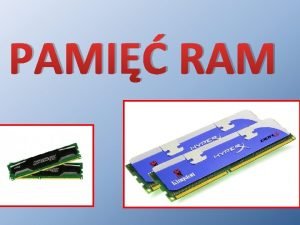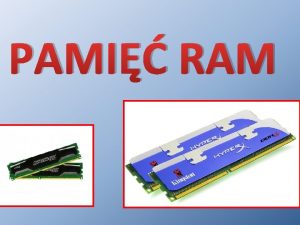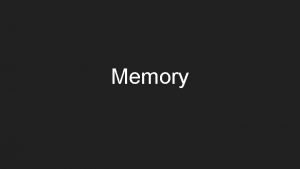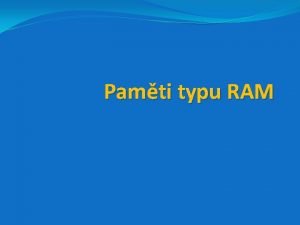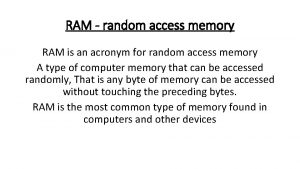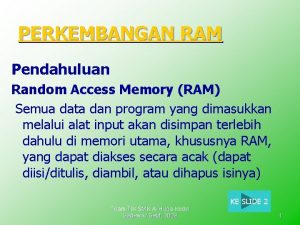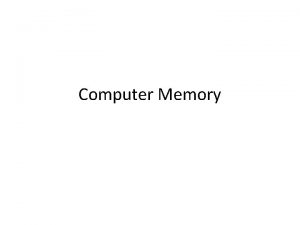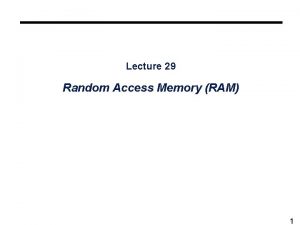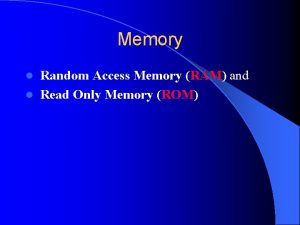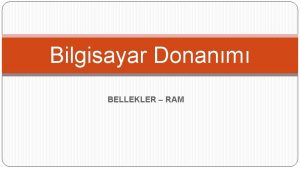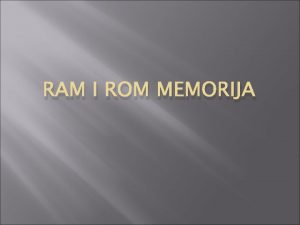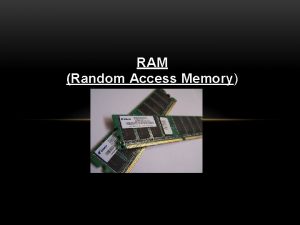The Little Man Computer RAM Random Access Memory































































































































































- Slides: 159















The Little Man Computer





ﺍﻧﻮﺍﻉ ﺣﺎﻓﻈﻪ ﺍﺻﻠی RAM( Random Access Memory) ROM( Read Only Memory) PROM( Programmable ROM) EPROM( Erasable PROM)


ROM ¨ Non-volatile memory to hold software that is not expected to change over the life of the system ¨ Magnetic core memory ¨ EEPROM – Electrically Erasable Programmable ROM – Slower and less flexible than Flash ROM ¨ Flash ROM – Faster than disks but more expensive – Uses • BIOS: initial boot instructions and diagnostics • Digital cameras

ﻇﺮﻓیﺖ ﺣﺎﻓﻈﻪ ﻇﺮﻓیﺖ ﻣﺤﺎﺳﺒﻪ ﺑﺮﺍی ﻓﺎکﺘﻮﺭ ﺩﻭ ¨ MAR ﻫﺎی ﺑیﺖ ﺗﻌﺪﺍﺩ -1 LMC = 100 (00 to 99) • 2 K where K = width of the register in bits • ﺩﺳﺘﻮﺭﺍﻟﻌﻤﻞ آﺪﺭﺱ ﻗﺴﻤﺖ -2 4 bits allows 16 locations • 8 bits allows 256 locations • 32 bits allows 4, 294, 967, 296 or 4 GB • کﺎﺭﺍیی ﺩﺭ ﺣﺎﻓﻈﻪ ¨ ﺍﻫﻤیﺖ Insufficient memory can cause a processor to work at 50% – below performance



Cache




Fetch-Execute Cycle Two-cycle process because both instructions ¨ and data are in memory Fetch ¨ Decode or find instruction, load from memory into – register and signal ALU Execute ¨ Performs operation that instruction requires – Move/transform data –

MDR ﻭ MAR ﺭﺍﺑﻄﻪ ﺑیﻦ Address Data

MAR-MDR msb(memory storage buffer) lsb(latest significant byte) ﻣﺜﺎﻝ


Load Fetch/Execute Cycle 1. PC -> MAR Transfer the address from the PC to the MAR 2. MDR -> IR Transfer the instruction to the IR 3. IR(address) -> MAR Address portion of the instruction loaded in MAR 4. MDR -> A Actual data copied into the accumulator 5. PC + 1 -> PC Program Counter incremented

Store Fetch/Execute Cycle 1. PC -> MAR 2. MDR -> IR 3. IR(address) -> MAR Transfer the address from the PC to the MAR Transfer the instruction to the IR Address portion of the instruction loaded in MAR 4. A -> MDR* Accumulator copies data into MDR 5. PC + 1 -> PC Program Counter incremented *Notice how Step #4 differs for LOAD and STORE

ADD Fetch/Execute Cycle 1. PC -> MAR Transfer the address from the PC to the MAR 2. MDR -> IR Transfer the instruction to the IR 3. IR(address) -> MAR Address portion of the instruction loaded in MAR 4. A + MDR -> A Contents of MDR added to contents of accumulator 5. PC + 1 -> PC Program Counter incremented

Instruction Elements ¨ OPCODE: task ¨ Source OPERAND(s) Addresses ¨ Result OPERAND – Location of data (register, memory) • Explicit: included in instruction • Implicit: default assumed OPCODE Source OPERAND Result OPERAND

Instruction Types ¨ Data Transfer (load, store) – Most common, greatest flexibility – Involve memory and registers – What’s a word ? 16? 32? 64 bits? ¨ Arithmetic – Operators + - / * ^ – Integers and floating point ¨ Logical or Boolean – Relational operators: > < = – Boolean operators AND, OR, XOR, NOR, and NOT ¨ Single operand manipulation instructions – Negating, decrementing, incrementing

More Instruction Types ¨ Bit manipulation instructions – Flags to test for conditions ¨ Shift and rotate ¨ Program control ¨ Stack instructions ¨ Multiple data instructions ¨ I/O and machine control ﺩﻛﺘﺮ ﻛﺎﻫﺎﻧﻲ - ﻣﺒﺎﻧی کﺎﻣپیﻮﺗﺮ

Register Shifts and Rotates

Stack Instructions ¨ Stack instructions – LIFO method for organizing information – Items removed in the reverse order from that in which they are added Push Pop

Fixed Location Subroutine Return Address Storage:




Point-to-point vs. Multipoint Plug-in device Broadcast bus Example: Ethernet Shared among multiple devices



PC ﺍﺭﺗﺒﺎﻃﺎﺕ ﺩﺭ AGP(Accelerated Graphics Port) PCI(Peripheral Component Interconnect) ISA(Industry Standard Architecture)








Basic Model ¨ Processing speed or program execution – determined primarily by ability of I/O operations to stay ahead of processor. Input Process Output

I/O Considerations Speed Issues ¨ CPU operates at speeds much faster than the fastest I/O device ¨ Devices operate at different speeds ¨ Character device, there is not any addressing or searching, printer, network card… ¨ Block devices (disk or tape drive) Coordination ¨ Several devices perform I/O simultaneously ¨ Unexpected input ¨ Various input formats ¨ Status information needed for each device

I/O Device Interface Issues ¨ Different formats – parallel interface – serial interface ¨ Buffering of data ¨ Burst vs. stream ¨ Different control requirements – electromechanical

Examples of I/O Devices

Simple I/O Configuration

I/O Modules Functions ¨ Recognizes messages from device(s) addressed to it and accepts commands from the CPU ¨ Provides a buffer where the data from memory can be held until it can be transferred to the disk ¨ Provides the necessary registers and controls to perform a direct memory transfer ¨ Physically controls the device ¨ Copies data from its buffer to the device/from the CPU to its buffer ¨ Notifies with interrupts

Input/Output Modules ¨ Programmed I/O – CPU controlled I/O ¨ Interrupt Driven I/O – External input controls ¨ Direct Memory Access Controllers – Method for transferring data between main memory and a device that bypasses the CPU

Programmed I/O

Programmed I/O Example

Programmed I/O Example

Interrupts ¨ Signal that causes the CPU to alter its normal flow on instruction execution – frees CPU from waiting for events – provides control for external input ¨ Examples – unexpected input – abnormal situation – illegal instructions – multitasking, multiprocessing

The CPU - The Interrupt Cycle § Fetch / Execute cycle § Interrupt cycle START Fetch Next Instruction HALT Execute Instruction Interrupts Disabled Check/Process Interrupt

Interrupt Terminology ¨ Interrupt lines (hardware) ¨ Interrupt request ¨ Interrupt handlers – Program that services the interrupt – Also known as an interrupt routine ¨ Process Control Block (PCB) – Located in a part of memory known as the stack area – All registers of a program are saved here before control is transferred to the interrupt handler

Interrupt Terminology ¨ Servicing the interrupt – suspends program in progress – saves pertinent information including last instruction executed and data values in registers in the PCB (process control block) – branches to interrupt handler

Servicing an Interrupt

Use of Interrupts ¨ Notify that an external event has occurred – real-time or time-sensitive ¨ Signal completion – printer ready or buffer full ¨ Allocate CPU time – time sharing ¨ Indicate abnormal event (CPU originates for notification and recovery) – illegal operation, hardware error ¨ Software interrupts

Multiple Interrupts Example

Basic CPU-Memory-I/O Pathway

External Interface Buses and Ports ¨ Parallel port ¨ Serial port – RS-232 C and RS-422 buses ¨ SCSI – Small Computer System Interface ¨ USB, USB-2 – Universal Serial Bus

















Storage Devices ¨ Primary memory ¨ Expanded storage ¨ Secondary storage – Data and programs must be copied to primary memory for CPU access – Permanence of data – Direct access storage devices (DASDs) – Online storage – Offline storage – loaded when needed

Speed ¨ Measured by access time and data transfer rate ¨ Access time: average time it takes a computer to locate data and read it – millisecond = one-thousandth of a second ¨ Data transfer rate: amount of data that moves per second

Hierarchy of Storage

Secondary Storage Devices ¨ Hard drives, floppy drives ¨ CD-ROM and DVD-ROM drives ¨ CD-R, CD-RW, DVD-RAM, DVD-RW ¨ Tape drives ¨ Network drives ¨ Direct access vs. Sequential access ¨ Rotation vs. Linear

Magnetic Disks ¨ ¨ ¨ Track – circle Cylinder – same track on all platters Block – small arc of a track Sector – pie-shaped part of a platter Head – reads data off the disk ¨ ¨ Head crash Parked heads Number of bits on each track is the same! Denser towards the center. CAV – constant angular velocity – Spins the same speed for every track – Hard drives – 3600 rpm – 7200 rpm – Floppy drives – 360 rpm

A Hard Disk Layout

Locating a Block of Data ¨ Average seek time: time required to move from one track to another ¨ Latency: time required for disk to rotate to beginning of correct sector ¨ Transfer time: time required to transfer a block of data to the disk controller buffer

Disk Access Times ¨ Avg. Seek time – average time to move from one track to another ¨ Avg. Latency time – average time to rotate to the beginning of the sector – Avg. Latency time = ½ * 1/rotational speed ¨ Transfer time – 1/(# of sectors * rotational speed) ¨ Total Time to access a disk block – Avg. seek time + avg. latency time + avg. transfer time

Magnetic Disks ¨ Data Block Format Disk Interleaving – Interblock gap – Header – Data – Formatting disk ¨ Disk Interleaving ¨ Disk Arrays – RAID – mirrored, striped – Majority logic fault-tolerant computers

Disk Block Formats Single Data Block Header for Windows disk

Alternate Disk Technologies ¨ Removable hard drives – Disk pack – disk platters are stored in a plastic case that is removable – Another version includes the disk head and arm assembly in the case ¨ Fixed-head disk drives – One head per track – Eliminates the seek time ¨ Bernoulli Disk Drives – Hybrid approach that incorporates both floppy and hard disk technology – Zip drives

Optical Storage ¨ Reflected light off a mirrored or pitted surface ¨ CD-ROM – Spiral 3 miles long, containing 15 billion bits! – CLV – all blocks are same physical length – Block – 2352 bytes • 2 k of data (2048 bytes) • 16 bytes for header (12 start, 4 id) • 288 bytes for advanced error control ¨ DVD-ROM – 4. 7 G per layer – Max 2 layers per side, 2 sides = 17 G

Optical Storage ¨ Laser strikes land: light reflected into detector ¨ Laser strikes a pit: light scattered

Layout: CD-ROM vs. Standard Disk CD-ROM Hard Disk

CD-ROMs

Types of Optical Storage ¨ WORM Disks – Write-once-read-many times – Medium can be altered by using a medium-powered laser to blister the surface – Data stored in concentric tracks, sectored like a magnetic disk ¨ Medium-powered laser blister technology also used for – CD-R, DVD-ROM – CD-RW, DVD-RAM, DVD+RAM

Displays ¨ Pixel – picture element ¨ Size: diagonal length of screen ¨ Resolution (pixels on screen) – VGA: 480 x 640 – SVGA: 600 x 800 – 768 x 1024 – 1280 x 1024 ¨ Picture size calculation – Resolution * bits required to represent number of colors in picture – Example: 16 color image, 100 pixels by 50 pixels 4 bits (16 colors) * 100 * 50 = 20, 000 bits

Display Screen ¨ Screen size: measured diagonally ¨ Resolution: minimum identifiable pixel size ¨

Color and Displays ¨ Pixel color is determined by intensity of 3 colors – Red Green Blue or RGB ¨ 4 bits per color – 16 x 16 = 4096 colors ¨ 24 bit color (True Color) – 16. 7 million colors ¨ Video memory requirements are significant!

Text Monitors – 24 lines x 80 chars – A character is the smallest unit on a screen – Very little memory required – Fast for remote transmissions

Printers ¨ Dots vs. pixels – 300 -2400 dpi vs. 70 -100 pixels per inch – Dots are on or off, pixels have intensities ¨ Types – Typewriter /– obsolete – Dot matrix – usually 24 pins, impact printing – Inkjet – squirts heated droplets of ink – Laser jet

Creating a Gray Scale

Laser Printer Operation 1. 2. 3. 4. 5. 6. 7. Dots of laser light are beamed onto a drum Drum becomes electrically charged Drum passes through toner which then sticks to the electrically charged places Electrically charged paper is fed toward the drum Toner is transferred from the drum to the paper The fusing system heats and melts the toner onto the paper A corona wire resets the electrical charge on the drum

Laser Printer Operation

Laser Printer Operation

Other Computer Peripherals ¨ Scanners – Flatbed, sheet-fed, hand-held – Light is reflected off the sheet of paper ¨ User Input Devices – Keyboard, mouse, light pens, graphics tablets ¨ Communication Devices – Telephone modems – Network devices

ﻧﻤﻮﻧﻪ ﻇﺮﻓﻴﺖ ﻭﺳﻴﻠﻪ ﻧﻮﻉ 20 -300 g Hard Disk 1. 4 m Floppy Disk 700 m CD 5. 2 g DVD 250 m Zip 4 - 100 g Tape


System Software Programs that maintain operation of computer Two types are operating systems and utility programs Operating system (OS) (sometimes called the platform) coordinates all activities among computer hardware resources p. 398

Operating System ¨ A program that controls the execution of application programs ¨ An interface between applications and hardware

Operating System ¨ Management – Memory – Process – i/o – file ¨ Virtual machine

Layers of Computer System

Services Provided by the Operating System ¨ Program development – Editors and debuggers ¨ Program execution ¨ Access to I/O devices ¨ Protected access to files

Services Provided by the Operating System ¨ Error detection and response – internal and external hardware errors • memory error • device failure – software errors • arithmetic overflow • access forbidden memory locations – error recovery


Uniprogramming ¨ Processor must wait for I/O instruction to complete before preceding

Multiprogramming When one job needs to wait for I/O, the ¨ processor can switch to the other job

Multiprogramming

Time Sharing ¨ Using multiprogramming to handle multiple interactive jobs ¨ Processor’s time is shared among multiple users ¨ Multiple users simultaneously access the system through terminals

Main OS Concepts ¨ Processes ¨ Memory Management ¨ Information protection and security ¨ Scheduling and resource management ¨ System structure

Processes ¨ A program in execution ¨ An instance of a program running on a computer ¨ The entity that can be assigned to and executed on a processor ¨ A unit of activity characterized by a single sequential thread of execution, a current state, and an associated set of system resources

Process ¨ Consists of three components – An executable program – Associated data needed by the program – Execution context of the program • All information the operating system needs to manage the process

Process

Memory Management ¨ Process isolation ¨ Automatic allocation and management ¨ Support for modular programming ¨ Protection and access control ¨ Long-term storage

Virtual Memory ¨ Allows programmers to address memory from a logical point of view

File System ¨ Implements long-term store ¨ Information stored in named objects called files

Paging ¨ Allows process to be comprised of a number of fixed-size blocks, called pages ¨ Virtual address is a page number and an offset within the page ¨ Each page may be located any where in main memory ¨ Real address or physical address in main memory


Virtual Memory Addressing

Types of Operating Systems Stand-alone: complete operating system working on PC, laptop, mobile computing device. like DOS, Windows, Mac OS X, Unix, Linux Network: OS designed specially to support a network, like netware, windows server 2003, Unix, Linux and Solaris Embedded : OS on most PDA and small devices Like, windows CE, windows mobile 2003, Palm OS and Symbian OS

Stand-Alone Operating Systems DOS (Disk Operating System) • Developed in early 1980 s for personal computers • Hardly used today because it does not offer GUI • Used command-line interface when first developed, later included menus

Stand-Alone Operating Systems Microsoft Windows Version Year Released Windows 3. x 1990 Windows NT 3. 1 1993 Windows 95 1995 Windows NT Workstation 4. 0 1996 Windows 98 1998 Windows Millennium Edition 2000 Windows 2000 Professional 2000 Windows XP 2001

Stand-Alone Operating Systems Mac OS X Ø Available only for computers manufactured by Apple Ø Macintosh operating system has been model for most GUIs

Stand-Alone Operating Systems OS/2 Warp Client Ø Ø IBM’s GUI multitasking operating system Supports networking, Java, the Internet, and speech recognition

Stand-Alone Operating Systems UNIX Ø Used by power users because of its flexibility and power Ø Most versions offer GUI Ø Both a stand-alone and a network operating system

Stand-Alone Operating Systems Linux Ø Popular, free, multitasking UNIX-type operating system Ø Open-source software code is available to public Ø Both a stand-alone and a network operating system e Red Hat provides a version of Linux called Red Hat Linux. The GNOME graphical user interface is shown in this example.

Network Operating Systems ¨ Allows users to share printer, Internet access, ¨files, and programs on a network ¨ Administers security by establishing ¨user name and password for each user Solaris Net. Ware Designed for client/server networks Windows Server 2003 § Version of UNIX developed by Sun Microsystems Upgrade to Windows 2000 Server § Specifically for e-commerce applications OS/2 Warp Server for e-business IBM’s network operating system for businesses

Embedded Operating Systems Ø Found on most mobile computers, PDAs, and other small devices Ø Windows CE is scaled-down version of Windows

Embedded Operating Systems operating systems for PDAs ¨ Ø Ø Ø Pocket PC 2002 for Pocket PC Ø Newer versioins: Windows Mobile 5 & 6 Palm OS for Palm, Visor, and CLIE Embeded Linux

Embedded Operating Systems Mobile Operating systems • Windows Mobile Smartphone • A scaled down version of PDAs • Symbian Ø Ø Open-source, multitasking operating system designed for smart phones Make telephone calls, save appointments, browse Web, send and receive e-mail and faxes, and more

Utility Programs ¨ disk scanner Ø Ø Detects and corrects problems on hard disk or floppy disk Searches for and removes unnecessary files § backup utility Ø Ø Copies selected files or entire hard disk onto another disk or tape compress files during backup to require less storage space

Utility Programs disk defragmenter ¨ Ø Reorganizes files and unused space on hard disk so programs run faster fragmented disk file before defragmenting file after defragmenting

Utility Programs ¨ screen saver Ø Causes monitor’s screen to display moving image or blank screen if there is no activity for a specified time Ø To secure computer, user configures screen saver to require password to deactivate

Utility Programs ¨ diagnostic utility Ø Compiles technical information about hardware and some software Ø Prepares report outlining problems

Stand-Alone Utility Programs ¨ What is a virus? Ø Ø Potentially damaging computer program Affects computer without user’s knowledge SIGNS OF VIRUS INFECTION

Stand-Alone Utility Programs ¨ antivirus program Ø Ø Identifies and removes viruses in memory, storage media, and incoming files Must be updated frequently

Stand-Alone Utility Programs ¨ file compression utility Ø Shrinks size of files to free up room and improve performance Ø Compressed files are sometimes called zipped files, or rared files Ø Two popular utilities: Win. RAR and Win. Zip®

Stand-Alone Utility Programs ¨ personal firewall Ø Protects personal computer from unauthorized intrusions Ø Monitors all transmissions to and from computer
 Characters vs society
Characters vs society Parallel ram
Parallel ram Synchronous dynamic random access memory
Synchronous dynamic random access memory Advantages and disadvantages of arrays
Advantages and disadvantages of arrays Ram nam me lin hai dekhat sabme ram
Ram nam me lin hai dekhat sabme ram Ten little indian boys poem
Ten little indian boys poem 1 little 2 little 3 little indian
1 little 2 little 3 little indian Q9all
Q9all Ramcache
Ramcache Brp little man computer
Brp little man computer Little man computer download
Little man computer download Ram's head white hollyhock and little hills
Ram's head white hollyhock and little hills Random assignment vs random sampling
Random assignment vs random sampling Random assignment vs random selection
Random assignment vs random selection Internal organization of memory chips
Internal organization of memory chips Semiconductor ram memories in computer organization
Semiconductor ram memories in computer organization Ram types comparison
Ram types comparison Examples of random file organization
Examples of random file organization Random access control
Random access control Alohause reviews
Alohause reviews Random access adalah
Random access adalah In random access machine, instructions are executed
In random access machine, instructions are executed Semantic memory example
Semantic memory example Implicit explicit memory
Implicit explicit memory Long term memory vs short term memory
Long term memory vs short term memory Internal memory and external memory
Internal memory and external memory Primary memory and secondary memory
Primary memory and secondary memory Physical memory vs logical memory
Physical memory vs logical memory Which memory is the actual working memory?
Which memory is the actual working memory? Virtual memory
Virtual memory Virtual memory in memory hierarchy consists of
Virtual memory in memory hierarchy consists of Eidetic memory vs iconic memory
Eidetic memory vs iconic memory Shared vs distributed memory
Shared vs distributed memory Dma direct memory access
Dma direct memory access Edma memory
Edma memory Advantages of direct memory access
Advantages of direct memory access Access memory
Access memory Coe 301 kfupm
Coe 301 kfupm Direct access memory
Direct access memory Computer hardware
Computer hardware Access memory
Access memory Dma attack
Dma attack Memory access time
Memory access time Memory access pattern
Memory access pattern Terminal access controller access control system plus
Terminal access controller access control system plus Terminal access controller access-control system
Terminal access controller access-control system Random scan system
Random scan system Bible memory man
Bible memory man Who is he
Who is he Little space meaning
Little space meaning Grains sand drops
Grains sand drops Few a few ero
Few a few ero Little mouse, little mouse where is your house
Little mouse, little mouse where is your house Adverb of little
Adverb of little Fill in a little or a few
Fill in a little or a few Complete the sentences with a few or a little
Complete the sentences with a few or a little Hát kết hợp bộ gõ cơ thể
Hát kết hợp bộ gõ cơ thể Bổ thể
Bổ thể Tỉ lệ cơ thể trẻ em
Tỉ lệ cơ thể trẻ em Voi kéo gỗ như thế nào
Voi kéo gỗ như thế nào Tư thế worm breton
Tư thế worm breton Alleluia hat len nguoi oi
Alleluia hat len nguoi oi Môn thể thao bắt đầu bằng từ đua
Môn thể thao bắt đầu bằng từ đua Thế nào là hệ số cao nhất
Thế nào là hệ số cao nhất Các châu lục và đại dương trên thế giới
Các châu lục và đại dương trên thế giới Cong thức tính động năng
Cong thức tính động năng Trời xanh đây là của chúng ta thể thơ
Trời xanh đây là của chúng ta thể thơ Mật thư tọa độ 5x5
Mật thư tọa độ 5x5 Phép trừ bù
Phép trừ bù Phản ứng thế ankan
Phản ứng thế ankan Các châu lục và đại dương trên thế giới
Các châu lục và đại dương trên thế giới Thơ thất ngôn tứ tuyệt đường luật
Thơ thất ngôn tứ tuyệt đường luật Quá trình desamine hóa có thể tạo ra
Quá trình desamine hóa có thể tạo ra Một số thể thơ truyền thống
Một số thể thơ truyền thống Cái miệng bé xinh thế chỉ nói điều hay thôi
Cái miệng bé xinh thế chỉ nói điều hay thôi Vẽ hình chiếu vuông góc của vật thể sau
Vẽ hình chiếu vuông góc của vật thể sau Thế nào là sự mỏi cơ
Thế nào là sự mỏi cơ đặc điểm cơ thể của người tối cổ
đặc điểm cơ thể của người tối cổ Thế nào là giọng cùng tên?
Thế nào là giọng cùng tên? Vẽ hình chiếu đứng bằng cạnh của vật thể
Vẽ hình chiếu đứng bằng cạnh của vật thể Vẽ hình chiếu vuông góc của vật thể sau
Vẽ hình chiếu vuông góc của vật thể sau Thẻ vin
Thẻ vin đại từ thay thế
đại từ thay thế điện thế nghỉ
điện thế nghỉ Tư thế ngồi viết
Tư thế ngồi viết Diễn thế sinh thái là
Diễn thế sinh thái là Dạng đột biến một nhiễm là
Dạng đột biến một nhiễm là Bảng số nguyên tố lớn hơn 1000
Bảng số nguyên tố lớn hơn 1000 Tư thế ngồi viết
Tư thế ngồi viết Lời thề hippocrates
Lời thề hippocrates Thiếu nhi thế giới liên hoan
Thiếu nhi thế giới liên hoan ưu thế lai là gì
ưu thế lai là gì Hổ sinh sản vào mùa nào
Hổ sinh sản vào mùa nào Khi nào hổ con có thể sống độc lập
Khi nào hổ con có thể sống độc lập Hệ hô hấp
Hệ hô hấp Từ ngữ thể hiện lòng nhân hậu
Từ ngữ thể hiện lòng nhân hậu Thế nào là mạng điện lắp đặt kiểu nổi
Thế nào là mạng điện lắp đặt kiểu nổi Zacchaeus was a wee little man words
Zacchaeus was a wee little man words Once upon a time there lived an ant and a butterfly
Once upon a time there lived an ant and a butterfly Zechariah was a wee little man
Zechariah was a wee little man Memory system design in computer architecture
Memory system design in computer architecture Types of computer memory
Types of computer memory Explain virtual memory in computer architecture
Explain virtual memory in computer architecture Computer architecture
Computer architecture Advanced dram organization
Advanced dram organization Computer memory hierarchy
Computer memory hierarchy Computer memory for short term storage
Computer memory for short term storage Computer memory presentation
Computer memory presentation Memory organization in computer architecture
Memory organization in computer architecture Computer memory hierarchy diagram
Computer memory hierarchy diagram Internal memory in computer architecture
Internal memory in computer architecture Computer memory system overview
Computer memory system overview Computer memory hierarchy diagram
Computer memory hierarchy diagram Computer memory system overview
Computer memory system overview Computer memory analogy
Computer memory analogy Smallest unit of storage
Smallest unit of storage Computer memory representation
Computer memory representation Memory latency in computer architecture
Memory latency in computer architecture What is computer memory
What is computer memory Memory in computer
Memory in computer Symbol table in assembler
Symbol table in assembler What is computer memory
What is computer memory Emerging memory technologies
Emerging memory technologies Memory locations and addresses in computer organization
Memory locations and addresses in computer organization Draw memory hierarchy diagram
Draw memory hierarchy diagram The act of obtaining unauthorized information
The act of obtaining unauthorized information Social is defined as gaining unauthorized access
Social is defined as gaining unauthorized access Simultaneous access in network
Simultaneous access in network Through one man
Through one man You live and learn
You live and learn Volym massa densitet
Volym massa densitet A hungry man is a angry man
A hungry man is a angry man Old man and new man
Old man and new man Menssyklusen
Menssyklusen Man vs society in the cask of amontillado
Man vs society in the cask of amontillado Internal definition literature
Internal definition literature Man vs man conflict definition
Man vs man conflict definition Carnal man
Carnal man Mein gott liebt jeden menschen
Mein gott liebt jeden menschen Rich man poor man bible
Rich man poor man bible The white man's burden political cartoon meaning
The white man's burden political cartoon meaning Man-computer symbiosis
Man-computer symbiosis Man-computer symbiosis
Man-computer symbiosis Major word formation
Major word formation Ramraj classes nashik
Ramraj classes nashik Semiconductor ram memories
Semiconductor ram memories Hanuman gosai meaning
Hanuman gosai meaning Unisys server ram
Unisys server ram Ramweb
Ramweb Famweb csu
Famweb csu Simav ram
Simav ram Motherboard expansion
Motherboard expansion Caracteristicas de la memoria
Caracteristicas de la memoria Static and dynamic ram
Static and dynamic ram Ram body builder
Ram body builder Vroulike vorm van koei
Vroulike vorm van koei Fram vs dram
Fram vs dram Fram (ferroelectrics ram)
Fram (ferroelectrics ram) Manavgat ram
Manavgat ram
